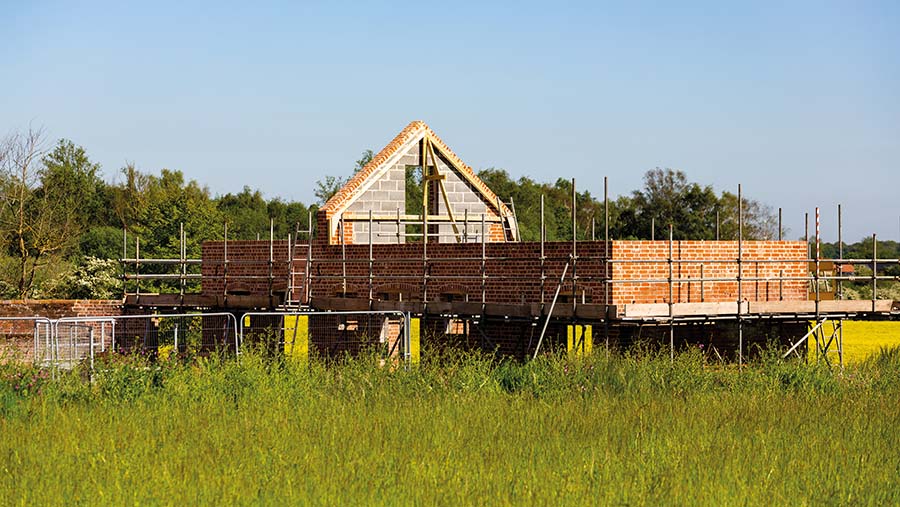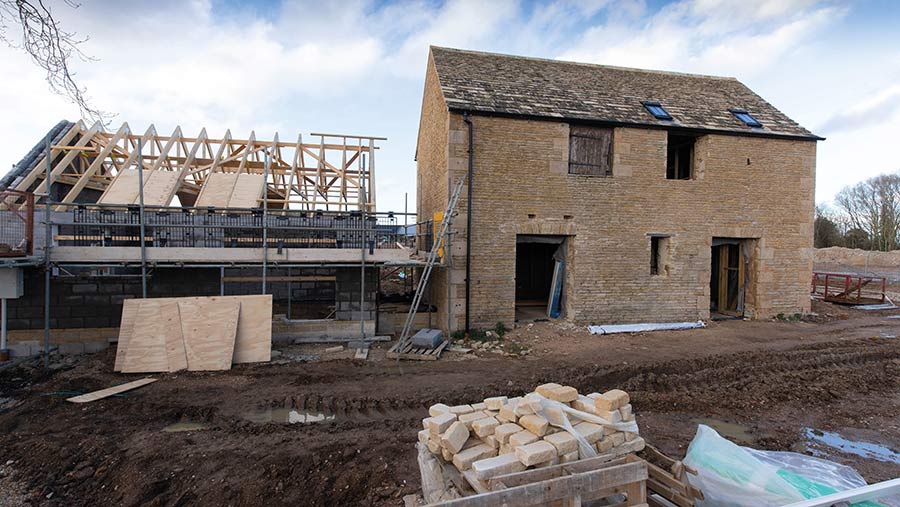Expert Q&A: Land development decisions and planning pitfalls
 © Collins Photography/Adobe Stock
© Collins Photography/Adobe Stock Attempting to gain planning permission or selling land for a one-off development windfall can lead to some tricky negotiations.
Bidwells’ residential development partner Hannah Beamish, planning partner Rob Hopwood and rural associate Louise Newton answer some of farmers’ most pressing questions.
See also: Farm buildings: Know your permitted development rights
What are the most common issues with planning applications?
Rob Hopwood: Applicants can underestimate the high level of detail required by local planning authorities to register and consider a planning application.
Applications will be delayed or even refused if planning policy and site issues are not sufficiently recognised or mitigated.
Applicants need to consider what impacts their proposals might have on neighbours, local infrastructure, services and the environment.
It is so important to highlight any key issues and understand how to deal with the issues before an application is submitted.
It is also very useful to identify who the local decision-takers are and obtain their views in a timely manner, such as parish, district and county councillors.
What key recent updates or changes do landowners need to be aware of?
Hannah Beamish: The residential development land market is currently extremely buoyant, with scarcity of immediate development opportunities driving land values to record highs.
During the lockdown periods, a lot of planning applications have been held up, creating a lack of supply, which is heating up the land market and encouraging house builders to look at sites they would not normally have considered two or three years ago.
RH: All new developments going forward will be required by authorities to deliver a 10% uplift in biodiversity, either on or off site.
This emerging field of biodiversity net gain has become hugely important when preparing applications. It requires specialist advice and a good understanding of both legal frameworks and ecology.
Who is best to value the land as part of the development process?
HB: This depends on the nature of the valuation required. Each site is different and requires specialist advice from a suitably qualified agent.
How are deals brokered and delivered in practice?
HB: You only sell your land once, so you must be happy with your commercial terms and get that in the form of a legal agreement with your development partner.
Every site is different, but it is important to think about development projects in phases and break it down into milestones.
RH: Assessing the planning status of the site first and identifying the landowner’s immediate and long-term aspirations means you can align the disposal [sales] strategy and the planning strategy to deliver at different stages.
How do you identify and work with the right developer or promoter?
HB: It’s all about trust. You need an understanding of your partner’s objectives to create a relationship that aligns with your own.
If you simply want to maximise value, then you’re probably going to go with quite a commercial partner, but if you want to deliver a real legacy then you should seek out someone with the same philosophy.
How do I come up with a vision for developing my land?
HB: One of our key roles is to help landowners think about what they could realistically do with their land. It is important to consider your overall objectives early on in the process.
RH: It’s great to dream, but you must at some point fix it down. The idea is to help landowners create a vision or help form it, in a viable and practical way.
It is vital to understand the true extent of a landowner’s objectives, and we can help develop a viable and workable strategy.
What are the right conditions for securing planning permission?
RH: The housing need in an area is very important. If there is a shortfall in supply then conditions are better for getting a yes from the planners.
Currently, supply is low and values are high, which creates a planning opportunity in many places.
New draft policies might also be emerging in a new local plan for the area – for housing, affordable housing, employment, retail or leisure facilities – which may offer the opportunity to plan and deliver a form of development that is needed locally.
HB: A local landowner is embedded in the local community so is often in a good position to understand the local community, infrastructure and environmental benefits that might be delivered in a development.
What sort of agreement with a developer would give the local authority comfort that the site will be delivered?
RH: A well-negotiated planning permission should be flexible and viable or it may not get built.
A planning and residential development consultant can help to secure a marketable planning consent by seeking to optimise the value of a site and securing a workable and deliverable permission.
A Section 106 agreement will also ensure that key council policy objectives are met and, at the same time, enable a developer to deliver a successful and high-quality environment.
Planning conditions will always be preferred to a legal agreement as they can be appealed or varied by an applicant more easily than a legal agreement.
How can a planning consultant be useful?
RH: A planning consultant will identify the most important issues at the outset of a proposal and advise how the issues can be best dealt with to reduce the risk of obtaining a refusal from the council.
If the landowner is considering a development proposal that they feel may be outside their skillset, it may be beneficial to employ a planning consultant to provide clear and timely advice.
There will be a cost for a planning consultant to provide advice, but the advice given at an early stage can save unnecessary abortive costs later in the application process.
Is it best to enter an option or promotion agreement?
HB: All sites have their own distinct issues and opportunities, so there is no one rule to apply here.
When you enter into an option agreement, you’re entering into it under a different premise than you would under a promotion agreement. It all depends on the time, effort and risk you have the appetite for.

© Tim Scrivener
Is it worth developing a barn with full planning permission before selling, or would selling it to a developer first provide a greater return?
Louise Newton: There are many factors to consider when deciding whether to sell a building with planning in place, or whether to undertake the development yourself.
It will ultimately depend on the level of cost and risk you are willing to take on. Local markets are hugely influential, as is the cost of materials. Assessments should be made on a site-by-site basis.
What is the difference between green belt and brownfield land?
LN: Annex 2 of the National Planning Policy Framework defines what is and what is not brownfield (previously developed land).
Previously developed land definition: Land which is or was occupied by a permanent structure, including the curtilage of the developed land (although it should not be assumed that the whole of the curtilage should be developed) and any associated fixed surface infrastructure.
This excludes: land that is or was last occupied by agricultural or forestry buildings; land that has been developed for minerals extraction or waste disposal by landfill, where provision for restoration has been made through development management procedures; land in built-up areas such as residential gardens, parks, recreation grounds and allotments; and land that was previously developed but where the remains of the permanent structure or fixed surface structure have blended into the landscape.
Of course, each site situation may be unique and planning history and site works could be a factor in assessing the status of any given site.
Is a farmyard with let units a brownfield site in terms of planning classification?
RH: If the let units have the benefit of planning permission or a certificate of lawfulness (both depend on the uses occurring) and the units have been or are being occupied, then there is an argument to be made that the land and buildings associated with the lets could be considered as previously developed land (and thus brownfield).
If a landowner is successful with a Class Q application, can that open the door to additional development?
LN: Class Q permitted development has a number of stringent criteria and conditions that need to be complied with in order to achieve prior approval. It is correct that Class Q can open up opportunities for additional development.
Essentially, Class Q can be used as a “fallback position” to achieve additional development, such as the demolition of the agricultural building and replacement with a new dwelling, which may be the preferred development for the site.
However, any additional proposal will be subject to assessment under full planning, so you will need to be aware of any planning policies that may restrict what can be achieved.
See the three-part Landowner-led development webinar series which explores the opportunities available for landowners in building a legacy through development.
